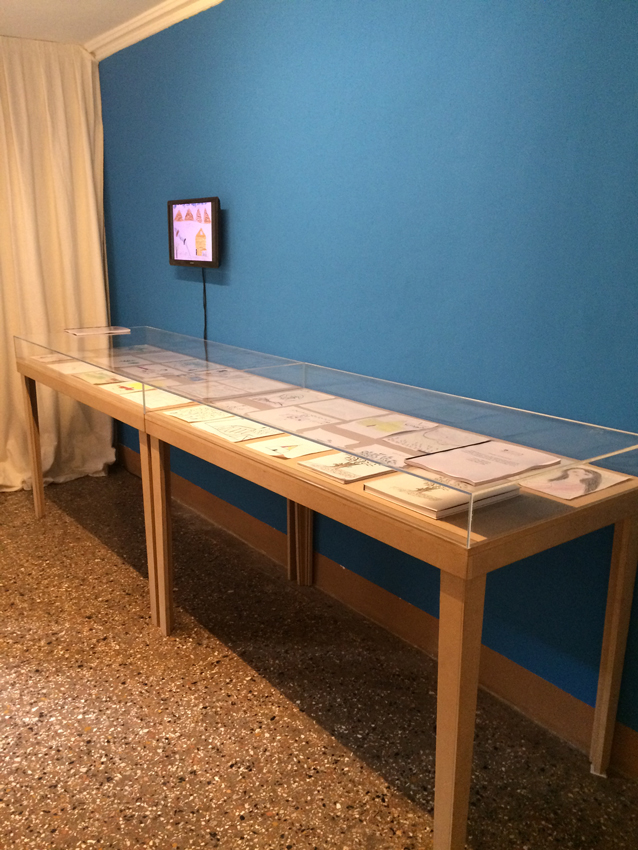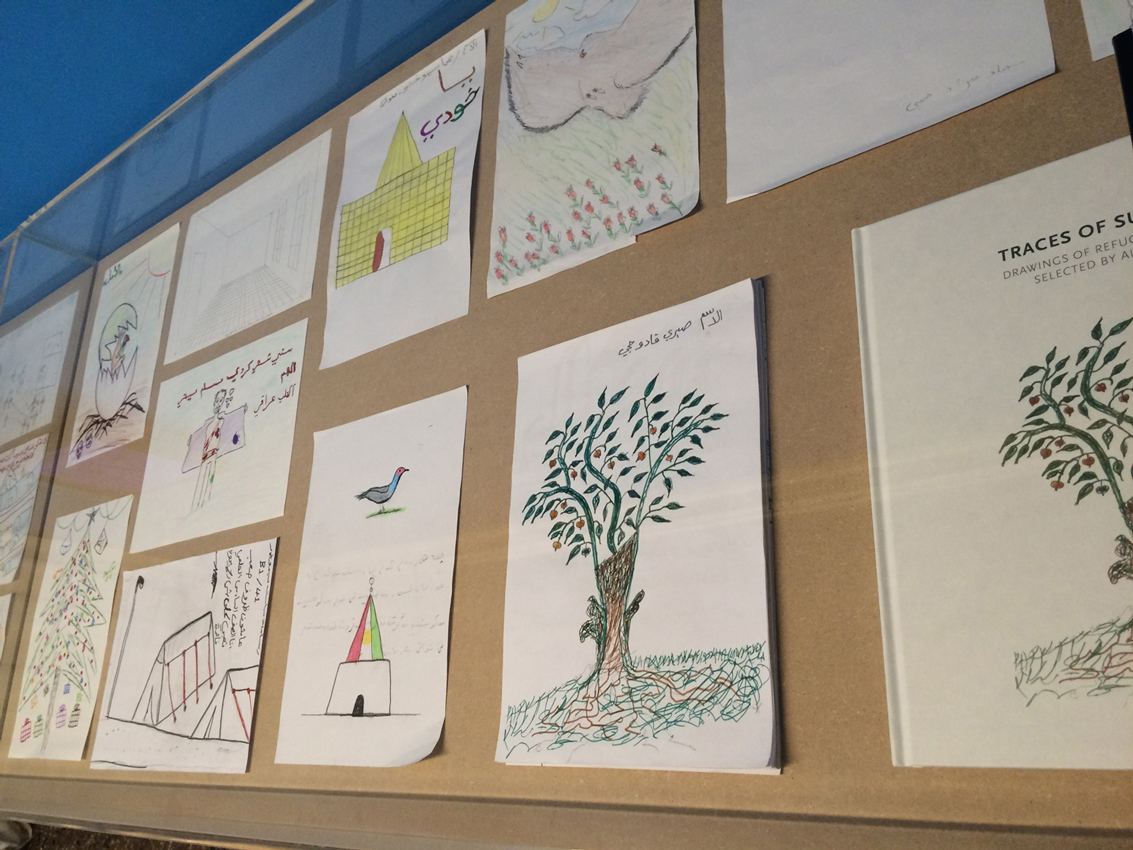Shows
National Pavilion of Iraq at the 56th Venice Biennale



The Venice Biennale—the world’s oldest, and arguably the most prestigious, visual arts event—often brings the politics of national representation to the global stage. There is no more apt example than this year's Iraq Pavilion, which is supported by the Ruya Foundation for Contemporary Culture in Iraq. The bipart exhibition consists of “Invisible Beauty”—curated by Philippe Van Cauteren, artistic director of SMAK Museum for Contemporary Art in Ghent, the Netherlands—and “Traces of Survival,” which showcases drawings created by refugees in Iraq that were selected by Chinese artist Ai Weiwei.
The Pavilion reacts and responds largely to Iraqi subjects who are suffering at the hand of the Islamic State (ISIS). After viewing the Pavilion, I was left wondering whether its focus on ISIS had overwhelmed other points of departure that are equally relevant to today's Iraqi artists. While I certainly do not deny the pervading presence of ISIS on Iraq, I felt that this dominating emphasis took away from the breadth of the rich, art historical tradition of the country.
Indeed, the Iraq Pavilion has created an interesting proposition in the way it has decided to present contemporary Iraqi art at the Biennale, with this year’s curator admittedly being very new to the country’s culture and history. Van Cauteren has said his intention for the Pavilion was to create “a dense reflection on how art relates to society,” and that the title of his curatorial project refers to “things that do not exist but are rendered unconscious or purposefully invisible due to a complex of geopolitical and cultural reasons.” He added, “'Invisible Beauty' gives voice to different generations of artists, all of whom are prisoners of the decay of a country.” For the exhibition, Van Cauteren chose five contemporary artists from Iraq and its diaspora who work in a range of media: photographers Latif al-Ani and Akam Shex Hadi; sculptor Salam Atta Sabri; painter Haider Jabbar; and performance artist Rabab Ghazoul. He made this selection following a journey to Iraq with Ruya Foundation chair and cofounder Tamara Chalabi, and visits to the studios of Iraqi artists working in the United States, Turkey, Belgium, and the United Kingdom.
Alongside Van Cauteren’s “Invisible Beauty,” which forms the majority of the Iraq Pavilion, is the other exhibition, “Traces of Survival,” which is also accompanied by a publication (with proceeds from the book going to the refugees in Iraq who participated in the show). In December 2014, the Ruya Foundation visited three refugee camps in Northern Iraq and provided drawing materials to the men and women living there for them to utilize. Over five days, 546 submissions of drawings, poetry and prose were collected from the camps. These were then provided to Ai Weiwei, who selected a number of the works for publication and to display at the Pavilion. In the exhibition, all 546 works are also being broadcast in a rolling slideshow.


Rather than utilizing the myriad artists, curators and specialists within the Iraqi diaspora to reflect on the nation's current climate or address the art historical implications of Iraq's involvement in over three decades of war, the Ruya Foundation’s impetus for the Venice Biennale is of another order: to create connections between a world-renowned curator, artists and Iraqi artists and refugees. Moreover, the global appeal of a “blockbuster” curator-artist duo has been cleverly harnessed to attract visitors to a national pavilion that is outside of the main Giardini/Arsenale domain. Yet it is still refreshing to see the exhibition foreground the work of emerging Iraqi artists and refugees, rather than include more recognizable names that would have overshadowed them. “Traces of Survival,” for instance, lets the refugees’ voice speak without being curatorially restrained. It is also notable that even Ai did not contextualize his engagement with these subjects, allowing for an unencumbered experience between the viewer and the refugees' work.

When I was in Venice, I spoke with two Iraqi artists to ask them their thoughts about the Pavilion. New York-based Wafaa Bilal (whose work was part of the Iranian Pavilion), admitted that he was confused about how the makeup of the Pavilion came together. He felt disappointed that the curator had little prior knowledge of Iraqi art. Bilal also stated that Van Cauteren did not have the right mix of artists and artwork to accurately reflect the country’s culture. “We are a reflection of our context,” he added. He felt the exhibition didn’t highlight the quality and complexity of work made by artists living inside and outside of Iraq. Another Iraqi artist, Mahmoud Obaidi, showing in a collateral event entitled “The Eye of the Thunderstorm,” was also unclear as to why Ai was chosen as the second "curator," and didn’t see a connection between the refugee project and the Chinese artist's practice.
However, all of these different artistic voices together are still provocative, calling on the international community to properly witness the artistic productions of Iraq. The Iraq Pavilion also demonstrates a seeming enthusiasm for future collaborations between the Ruya Foundation and other international arts organizations, as demonstrated by the fact that Van Cauteren’s exhibition will later travel to the SMAK Museum in 2016. Its exhibition catalogue is also of note, with contributions from various Western curators, many of whom write about their lack of knowledge of Iraqi contemporary art until this oppotunity to profile the participating artists for the publication. In addition, the catalogue includes the first English translations of certain Arabic literary texts. Perhaps this kind of outreach will introduce a new and more expansive audience to contemporary Iraqi art. However, a more productive approach for the Iraq Pavilion at this year’s Venice Biennale may have been to include current experts in the field, in a more explicit way. The catalogue may well become an important archive for the future of Iraqi art. Despite its potential, for the making of this year's Pavilion, it would have been equally important to consult the living archives of Iraqi art, who seemed to be neglected in the process of this project.









